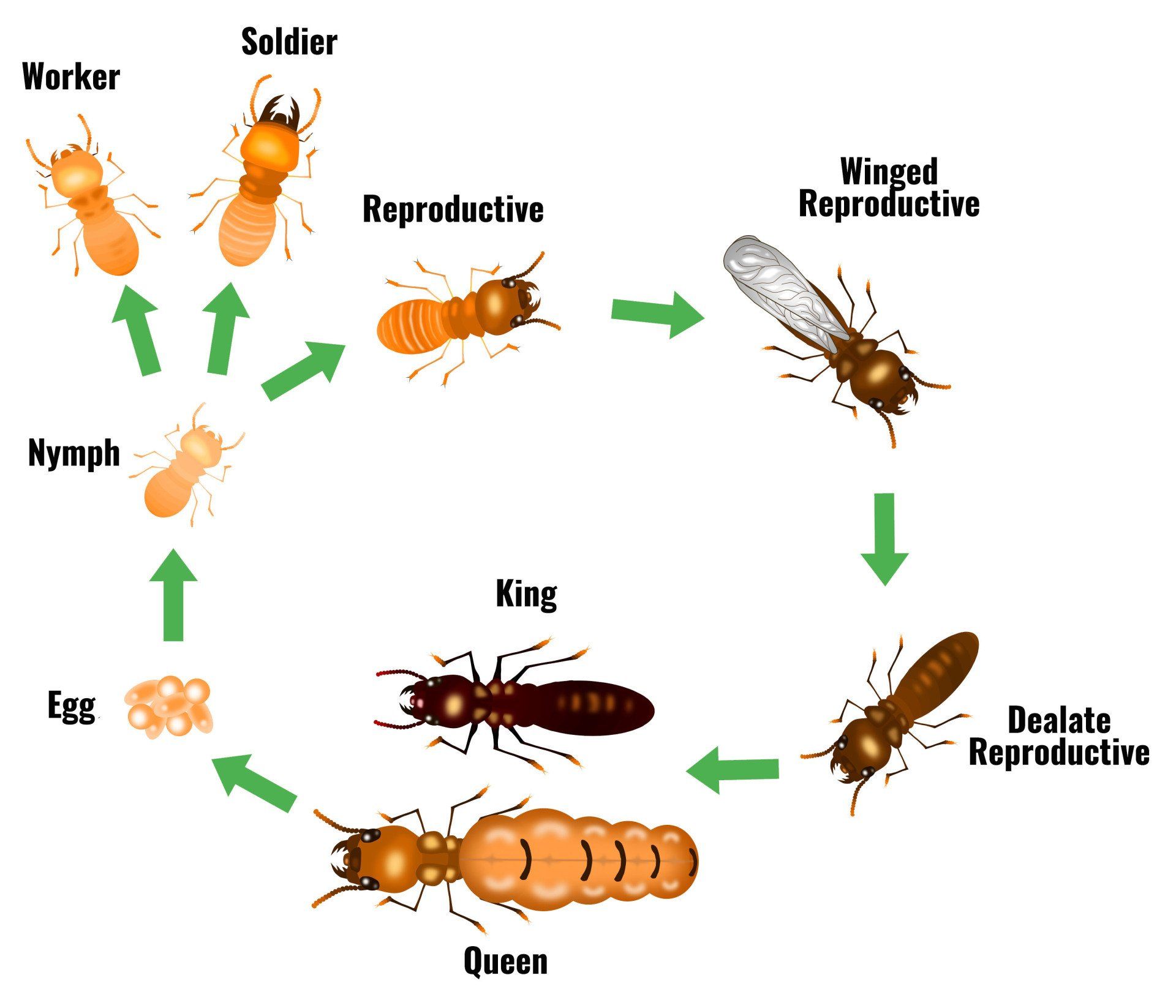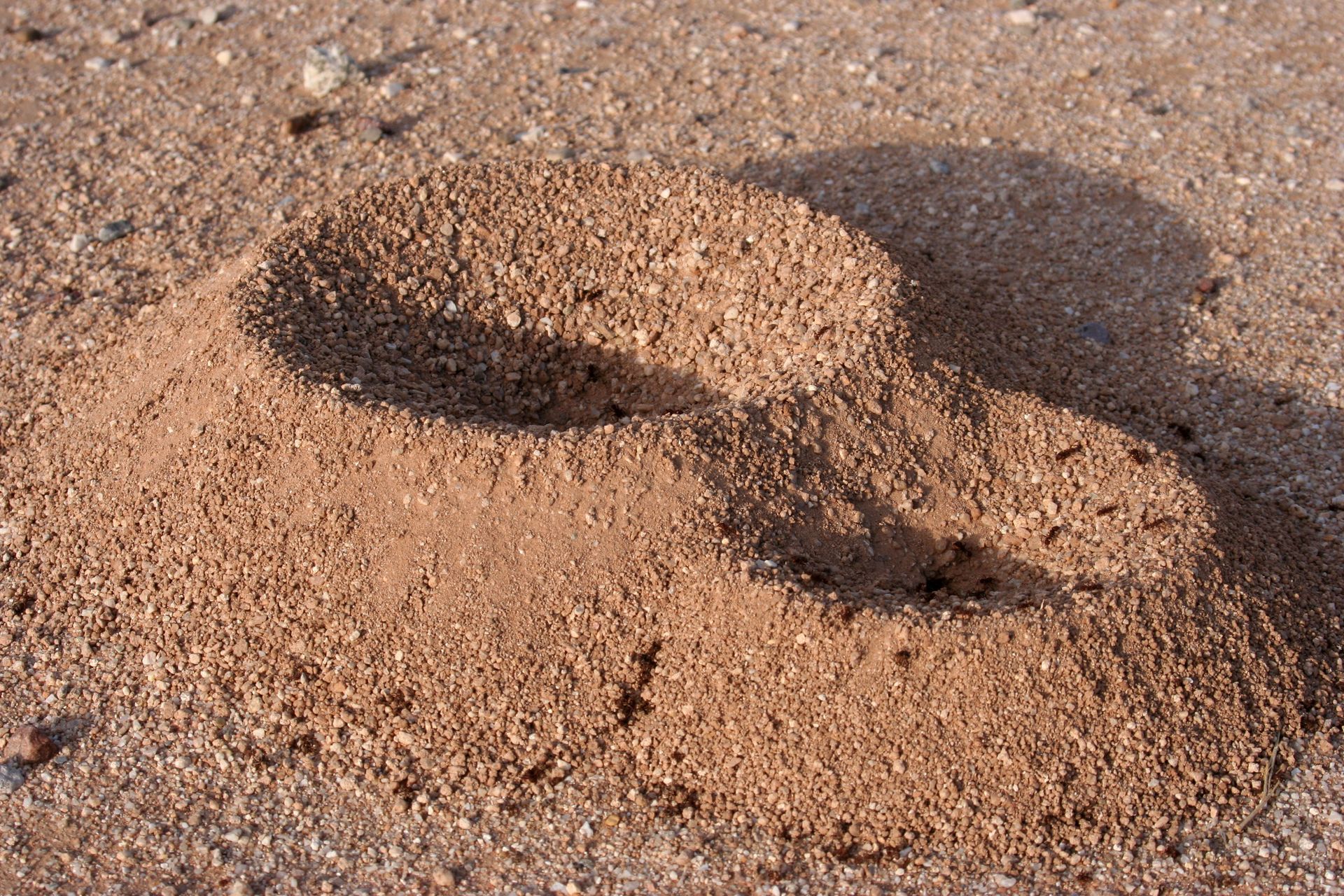Termite Life Cycle
Termite Life Span

A termite’s life cycle starts when a queen termite lays an egg. This egg will develop for 30 days before hatching and moving through a larval stage which is also called a nymph. With time, these nymphs will mature into an adult termite. Adult termites mature into one of several castes which is determined by the needs of the colony. Those castes include workers, soldiers, and reproductives called alates. Alates develop wings which allow them to swarm and look for new locations to create new termite colonies, which perpetuates the termite life cycle. Knowing the developmental patterns of termites can help you understand when and how termites can infest your property and how to effectively treat them.
Termite Development

Termites move through a process known as incomplete metamorphosis which generally takes them through several phases before reaching adulthood. The stages include:
Termite Eggs
Life begins with the termite egg which are tiny translucent orbs that are white or brown. These eggs have gestation period of roughly 30 days and will increase in size and change color as it nears time to hatch. These eggs need to be maintained by worker termites and the queen to ensure that they survive. Without the support and protection of the colony, the eggs will fail to hatch because they will become overwhelmed with bacteria or fungi.
Termite Nymphs & Larvae
Termite nymphs are soft, white, & immature termites in their larval stage. Initially, nymphs will be dependent on worker termites for food, but will eventually become independent. Once nymphs are capable of movement, they are relegated to helping support the worker termites in caring for termite eggs. They will proceed to molt several times as they mature into one of the 3 termite castes. The caste the termite nymph ends up in is dependent on the needs of the colony and determined by pheromones released by the queen. During this process, each molt is replaced with a larger and stronger exoskeleton until the nymph reaches its final stage of adulthood. The timeline of this entire process can take several months depending on factors like availability of resources, colony size, and colony climate.
Mature Termites
The final form of termites will fall into one of 3 castes. These mature termites all serve a very specific purpose and can change roles to fit the immediate needs of the colony. Most mature termites end up as workers but workers have the capability of shifting back into a nymph so it can develop further into one a more needed caste. This generally happens when the colony grows to large and reproductives are needed to expand the colony.
Termite Castes
The 3 castes that termites eventually develop into are workers, soldiers, and reproductive. Each role serves the colony in a very specific way designed to optimize the growth and overall health of the colony. They each have distinct physical attributes which help them play their roles in termite colony development.
Worker Termites
Termite workers are said to make up roughly 85% - 98% of most termite colonies. They are typically responsible for expanding the colony, caring for the eggs and nymphs, as well as feeding the rest of the colony. Worker termites move and communicate using their sense of touch and by using pheromones to help identify food and enemies. Subterranean worker termites will make a substance using their waste, saliva, and dirt to create mud tubes that will help them reach wooden structures they can feed on. Drywood worker termites will chew their way through wooden structures to expand the colony by making new pathways and chambers. Worker termites can be either gender and do not contribute to termite procreation because they are sterile.
Soldier Termites
Soldier termites play the role of colony protectors and have extra-large heads with large mandibles designed to fight predators like ants. The only downfall of the large mandible is that soldier termites are unable to feed themselves so workers must provide them with cellulose to consume. Like workers, soldiers are also sterile and are unable to contribute to colony growth.
Reproductive Termites
Reproductive termites are a class that includes all fertile termites including the queen and king. The queen and king are the primary reproductives while non-royal reproductives are known as supplementary reproductives or alates. In a crowd of alates, secondary reproductives and tertiary reproductives may also exist. These are termites that are ready to spread and become the queen of a new colony or one that would replace the current queen if it died. Alates are the winged termites that will swarm to create new satellite colonies once a colony has reached its capacity or run out of food. This event is called the nuptial flight which allows a swarm of reproductives to find a new location to create a secondary colony. Within this group of reproductives, only one will become a secondary queen and king while the rest will revert to workers or soldiers. Since alates are the only termite caste that will see the light of day, they will develop pigmentation and eyes to help them in their journey to find a new location for their colony.
Termite Queen & King
Once a swarm has identified a new colony location, one female and male will emerge as the queen and king. This couple will remain inside the nest for the rest of their lives and will produce millions of eggs over their lifetimes. The sole purpose of the queen is to produce healthy eggs so the colony can continue to expand. As the queen matures, her body will distend and become several times larger than she was as a reproductive. Her size makes her mostly immobile which means that she has to rely on the support of workers to help keep her fed and healthy. The termite king on the other hand is much smaller and capable of movement. That said, he remains by the queen’s side and never leaves the colony. The king plays a role in determining the caste of workers when the time comes for them to mature.
Termite Reproduction
The life cycle of the termite begins with the nuptial flight where a termite swarm leaves to find a location to build a new colony. After the colony has been created, one pair will emerge as the king and queen. This queen will start the reproduction cycle that will last several years before new secondary reproductives will emerge to expand the colony. At first the queen will be capable of producing only a handful of termites every day but as her body grows, she will eventually be producing up to 1000 eggs a day.
Termite Swarming
Without swarming, new termite colonies would never occur. This generally happens when a termite colony has reached a point where it has run out of food or if the colony needs to make room for additional growth. When this point comes, the termite kind and queen will indicate that it is time for nymphs to start developing into alates by sending the right pheromone signals. These nymphs will start to develop wing bud sites where wings will eventually emerge and functional eyes. Their exoskeletons will also darken and harden to help deal with the newfound exposure to sunlight. When the new batch of reproductive have grown in numbers, they will take off on their nuptial flight in search of a new place to call home.
Termite Life Span
The full lifespan of most termites only spans a couple years when accounting for time spent in the nymph stage. Workers and soldier termites generally live only 1 or 2 years after reaching maturity. Reproductives can live for up to 4 years. Queen termites typically survive for over a decade, with some species living as long as 20 – 25 years if the conditions are optimal. Even with such a long termite life span, their optimal egg laying days may be limited to just 8 - 10 years.
Drywood Termite Life Cycle
Drywood termite queens generally live between 10 – 12 years. Their colonies develop much slower and may take up to 5 years before the colony reaches a stable mature state.
Subterranean Termite Life Cycle
Subterranean termite queens have been known to live past 25 years with most living between 15 – 17 years. Subterranean termite colonies expand at a much faster rate with colonies reaching maturity at around 2 years.
How Long Does It Take for a Termite Colony to Mature?
Termite colonies take some time to mature but once they reach maturity, they can contain over a million termites. The time it takes for a colony to reach maturity largely depends on climate and species. Subterranean termite colonies can reach full maturity in 6 – 7 years with drywood termites taking significantly longer. These species will continue to expand under resources become limited. Once this happens the colony will disperse swarmers to find a new location to build upon. Some termite colonies that have enough resources have been known to exist for over 100 years. That being said, these colonies exist in places where structural damages are not being accounted for otherwise the colonies would have been treated and controlled.
Call EcoGuard Pest Management to Get Your Termite Inspection Scheduled Today
If you have noticed any signs of termites in any stage of its life cycle, it is time to call EcoGuard Pest Management to schedule a termite inspection right away. The amount of damage that can be done to you property is significant if left untreated.

















